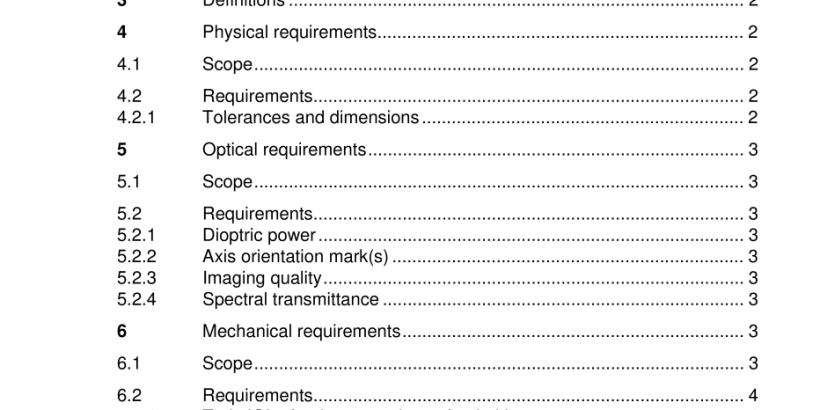ANSI Z80.30-2018 pdf download.Toric Intraocular Lenses
5.2.1 Dioptric power
Dioptric power is defined in ISO 11979-1. When determined by one of the methods described in Annex A of ISO 11979-2, the dioptric power in the meridians of highest and lowest dioptric power and the spherical equivalent power shall be within the tolerance limits for dioptric power specified in ISO 11979- 2. Additionally, the cylinder calculated by the absolute difference between the powers of the meridian of the highest dioptric power and the meridian of the lowest dioptric power shall be within the cylindrical power tolerance limits specified in ISO 11979-2.
5.2.2 Axis orientation mark(s)
The toric IOL shall have some physical mark, engraving or label to indicate the cylindrical axis. The angle difference between the physical axis indicator and the meridian with the lowest dioptric power shall be less than or equal to 5.0°.
5.2.3 Imaging quality
When the null lens method outlined in Annex A is used, the resolution efficiency requirements in ISO 11979-2 shall apply to the combined system of toric IOL and null lens. Alternatively, the Modulation Transfer Function (MTF) requirements of ISO 11979-2 shall apply to the meridians of highest and lowest dioptric power of the combined system of toric IOL and null lens. When other metrics or methods are used to assess toric IOL image quality, the manufacturer shall verify that toric IOLs that meet the minimum requirement of the new metric also meet either the resolution efficiency or MTF requirements of ISO 11979-2. The method in Annex A may be useful for such verification tests. An example of an alternative image quality metric and method is provided in Annex C.
7.3 Biological test requirements
The requirements in 7.3 of ANSI Z80.7 shall apply, with the following additional requirements: Manufacturers of new toric IOL materials shall include in their risk analysis an assessment of the potential for material changes such as calcification following implantation. The risk analysis should consider the history of clinical use of the material, and tests to assess the long-term stability of the material in an in-vivo environment. A monocular implantation test to assess the stability of the material shall be performed as outlined in ISO 11979-5. After the light microscopy evaluation of the explanted toric IOLs from the ocular implantation test (ANSI Z80.7, Annex C), half of the samples shall be thoroughly cleaned (if the optical surfaces can be cleaned without being damaged) and then assessed for changes in optical properties in accordance with the requirements in clause 5 of ANSI Z80.30. The other half of the samples shall then be evaluated by SEM/ EDX, where feasible, for surface changes. NOTE: The test or control material used for the ocular implantation test (ANSI Z80.7, Annex C) may be a representative sample of the toric IOL that has gone through the same fabrication methods as the device to be marketed, has a mass at least equivalent to the finished toric IOL, and has a size and shape that would allow the required post-retrieval evaluations to be performed, if its use can be justified.
7.4 Physicochemical test requirements
The requirements in 7.4 of ANSI Z80.7 shall apply, with the following additional requirements: The dioptric power shall be determined before and after testing if finished toric IOLs are used in hydrolysis testing. The refractive index shall be determined instead if a facsimile material is used. The dioptric power shall be within the tolerance limits in Table 1 in 5.2.1 of ANSI Z80.7 before and after hydrolysis testing, or the refractive index change should be used to determine the resulting power change for the nominal design and this difference shall be within the tolerance limits in Table 1 in 5.2.1 of ANSI Z80.7. The toric IOL material shall be assessed for the presence of residual insoluble inorganics in or on the lens arising from the manufacturing materials and process aids. Where possible residues have been identified, the lens shall be evaluated for such residuals. The test methods used for this evaluation shall be identified, validated and justified. Consideration shall be given to methods that use solvents that dissolve the contaminating materials and that have a detection limit of 0.2 μg/lens or 10μg/g. Correlation between these results and the results from biological tests, if any, shall be documented.ANSI Z80.30-2018 pdf download
